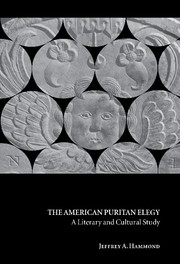Book contents
- Frontmatter
- Contents
- Preface
- Acknowledgments
- Introduction
- Chapter 1 Monuments enduring and otherwise
- Chapter 2 Toward an anthropology of Puritan reading
- Chapter 3 Weep for yourselves: the Puritan theology of mourning
- Chapter 4 This potent fence: the holy sin of grief
- Chapter 5 Lord, is it I?: Christic saints and apostolic mourners
- Chapter 6 Diffusing all by pattern: the reading of saintly lives
- Epilogue: Aestheticizing loss
- Notes
- Works cited
- Index
Chapter 4 - This potent fence: the holy sin of grief
Published online by Cambridge University Press: 22 September 2009
- Frontmatter
- Contents
- Preface
- Acknowledgments
- Introduction
- Chapter 1 Monuments enduring and otherwise
- Chapter 2 Toward an anthropology of Puritan reading
- Chapter 3 Weep for yourselves: the Puritan theology of mourning
- Chapter 4 This potent fence: the holy sin of grief
- Chapter 5 Lord, is it I?: Christic saints and apostolic mourners
- Chapter 6 Diffusing all by pattern: the reading of saintly lives
- Epilogue: Aestheticizing loss
- Notes
- Works cited
- Index
Summary
Dying assumed geometric clarity as the great divide not just between the living and the dead, but between the potential for salvation and the end of all redemptive opportunity. Edward Pearse declared in his treatise on preparing for death that for the unrepentant, dying marked the irreversible step “from Hope to Despair.” It brought the great “Change from fair probabilities to utter Impossibilities of Life and Salvation” (56). As Roy Harvey Pearce has aptly described it, “the occasion of a death, the point just before final proof of election or damnation, gave the Puritan poet his greatest opportunity. Now a man, newly dead, would really know. And the poet would bear witness to that knowledge, if only he could work out the way of getting it” (25). Fear of dying did not speak well to one's readiness for this final test. “O where's the man or woman,” Philip Pain asked, “that can cry, / Behold I Come, Death I desire to dye?” What was it, exactly, that made death so terrifying? Nothing, Pain insisted,
… but the sense
Of guilt and sin: Break down this potent fence,
And then be sure for aye you shall enjoy
Joyes everlasting, Everlasting joy. (Meserole 287)
The most daunting barrier stood not between the dead and the living, but between those destined to remain caught in sin's snares and those whom faith would set free.
- Type
- Chapter
- Information
- The American Puritan ElegyA Literary and Cultural Study, pp. 101 - 134Publisher: Cambridge University PressPrint publication year: 2000

